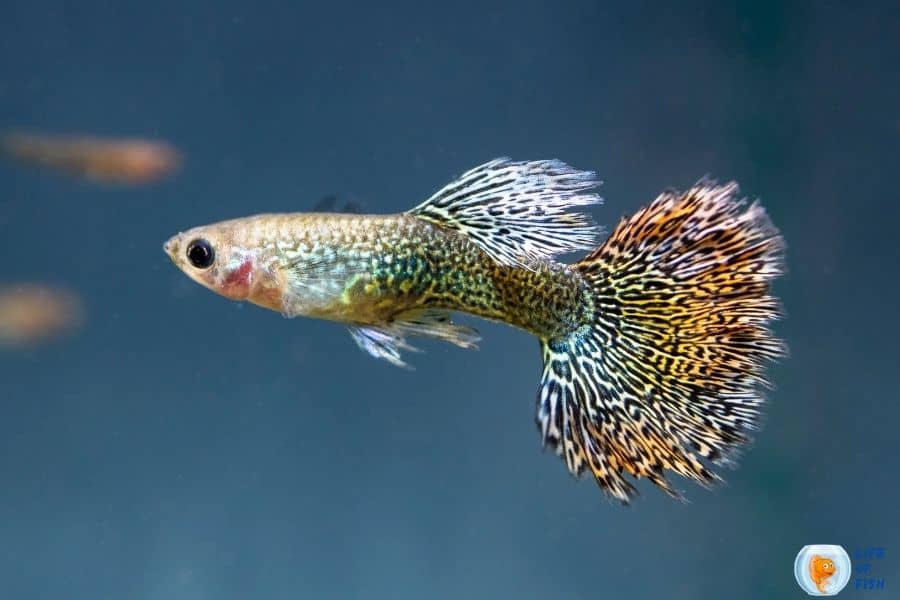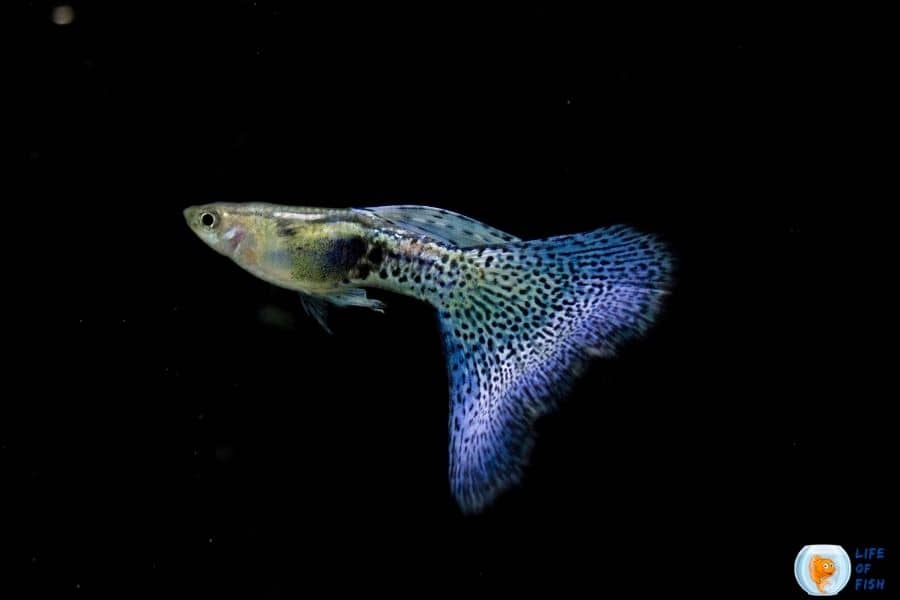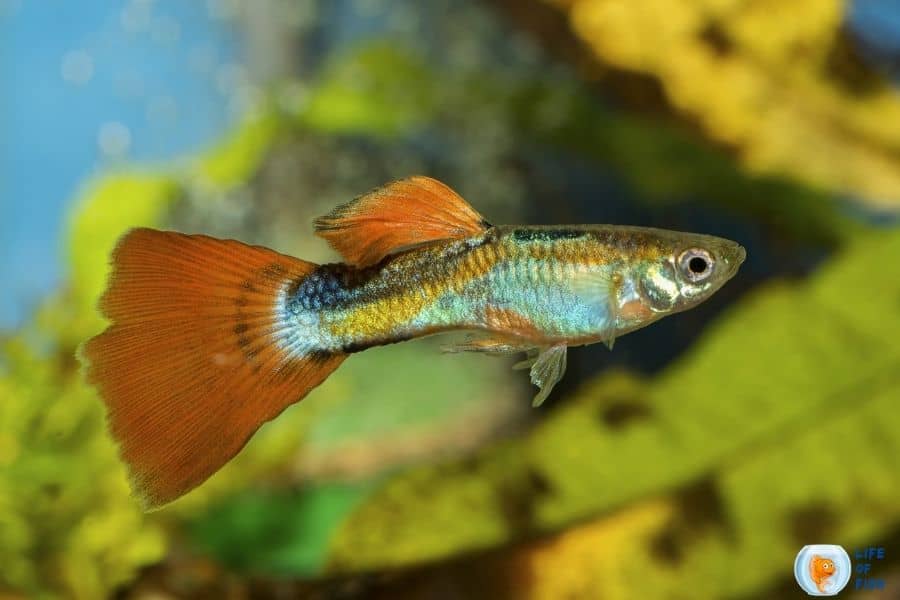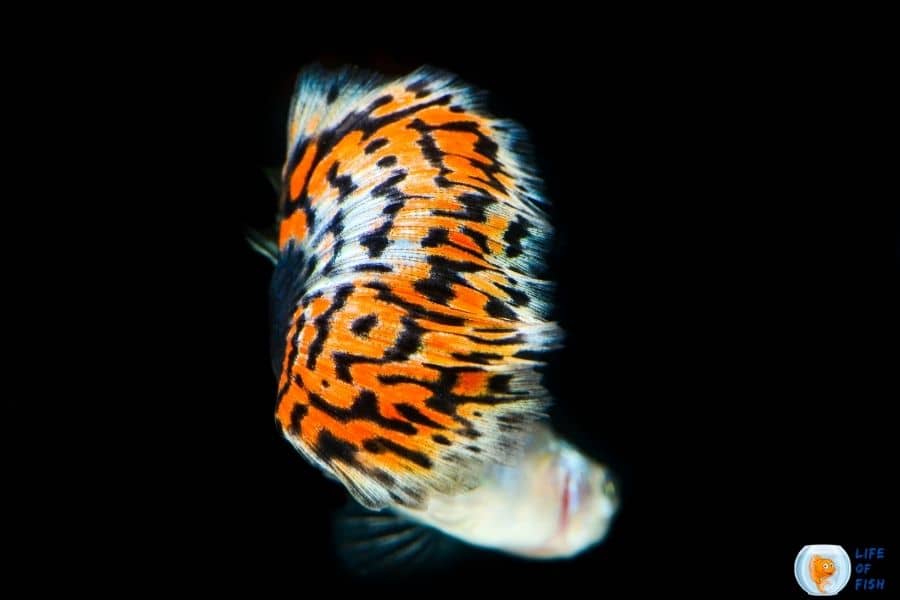Fin rot in guppies is a common ailment in the aquarium world. It can be challenging to diagnose, but fortunately, it is easy to treat with antibiotics and antifungal medications.
Fin rot is a disease usually caused by the bacteria, Pseudomonas flourescens. These bacteria are free-living organisms that do not need a fish host to survive and they infest your guppy’s fins in certain conditions causing them to rot away. The infection is usually caused by injuries sustained while fighting with other guppies or being bullied in the fish tank.
If you suspect your pet has fin rot and cannot confirm the disease, it is recommended to consult your veterinarian for a proper diagnosis and treatment plan. But by reading this article, you can have a clear idea about fin rot in guppies, the causes, symptoms, and treatment options. If you spot the fin rot symptoms early, you can easily cure your pet, and that is why we wrote this post to help your aquarium fish.
It is also essential to take fin rot preventive measures to have a happy, healthy pet in your fish tank. We covered that too, so read on.

What exactly is fin rot, and what causes it?
Jump To
- 1 What exactly is fin rot, and what causes it?
- 2 Fin rot in guppies
- 3 Does fin rot spread?
- 4 Can fin rot cure itself?
- 5 How do I know if my guppy has fin rot? Fin rot symptoms
- 6 The difference between bacterial fin rot and fungal fin rot
- 7 How do you treat fin rot in guppies?
- 8 Best antibiotic products to treat guppy fin rot
- 9 How long does Fin Rot take to heal?
- 10 How to prevent fin rot in guppies?
- 11 Conclusion
Still, it can also be brought about by poor water quality, poor diet, stress, or as another diseases’ secondary infection. Severe fin rot is easy to cure when caught early, but the fin will not grow back most of the time. Once the disease sets in your fish, it is rather difficult to cure and may eventually kill your fish while infecting other fish in your aquarium.
Fin rot in guppies
Fin rot is a common disease in guppies because their fins are very long and thin, making them prone to injury. Further, guppies are voracious eaters and produce a lot of waste, polluting the tank faster than other fish types. Therefore, you must maintain the water quality in their tank at a high level by performing regular water changes and fixing a high-quality water filter. Otherwise, poor water quality will cause guppies to catch bacterial and fungal infections like fin rot faster.
Does fin rot spread?
Fin rot is a contagious disease that can spread from fish to fish if kept together in the same aquarium. Once your guppies have been infected, it is important to separate them asap and treat each one with antibiotics so that you kill off any existing bacteria/fungus before they infect other healthy guppies.
Can fin rot cure itself?
Usually, healthy fish do not catch fin rot easily. It is unhealthy or stressed fish that get affected by fin rot. Once set in, the fish can not cure itself. The only way to cure severe fin rot is through antibiotics or anti-fungal medications.

How do I know if my guppy has fin rot? Fin rot symptoms
Knowing the symptoms of fin rot beforehand helps a lot when determining if your guppy has fin rot. It will also help you choose suitable treatment options for your sick fish. There is no definite list that describes all the signs, but we can say that there are some common ones like:
- Small tears and nibbling on fins (usually caused by fighting) or lost scales
- Fin loss starts with loss of color and transparency in one or more areas on your guppy’s fins.
- Over time the fins become shorter and shorter until they are completely gone.
- Reddening of the fin margins; this is where it becomes clear that your guppies have contracted fin rot because healthy fins are transparent with white, firm edges.
- Rotting fins, start at the base of your guppy’s fin and spreads outwards. As it progresses, you will notice some parts have become very red or pink with a cottony white growth on them too.
- You may also see holes in their fins that are caused by bacteria eating away at the tissue underneath.
(The cottony white growth is caused by a bacteria called Columnaris, common in poor quality water. Columnaris also causes your guppy’s fins to rot away.)
- Body rot; In the last stages of fin rot, the fish’s body also becomes affected and starts to rot away.
- The fish will show clear signs of being sick by acting lethargic, hiding a lot, or gasping at the surface because it’s having trouble breathing.
- Loss of appetite and energy is a sign that something serious has happened to your fish, or else he is suffering from stress. Do not let this go on for too long!
In the first stages of fin rot, it is easily treatable. But in the last stages, as we stated above, it is more likely that your fish will die soon.
The difference between bacterial fin rot and fungal fin rot
Before treating for fin rot, it is essential to identify the type of rot that your guppy is suffering from.
Bacterial fin rot is most commonly caused by poor water quality, so it usually responds well to antibiotics.
On the other hand, fungal fin rot can be found in both hard and soft water but responds better to salt bath treatments than antibiotics.
Thus, if you are unsure about the type of fin rot your guppy has contracted, it is best to start with aquarium salt. Bacterial fin rot appears uneven, and the fins are often more ragged than when caused by a fungal infection. On the other hand, fungal fin rot will be more evenly distributed across the fins. This can be accompanied by a white edge running over your guppies’ fins.
(However, if you observe white spots, it could be Ich.)

How do you treat fin rot in guppies?
You should start Fin rot treatment as soon as you see any of the above symptoms, or else it will worsen and kill your fish. Fin rot treatment is easy, as long as you catch the symptoms early and can accurately diagnose your fish with a microscope (which most aquarists cannot do).
When treating fin rot in guppies, isolating your fish in a quarantine tank (hospital tank) is always better than contaminating other fish.
You can treat the whole aquarium if you suspect all of your fish have caught the disease. However, be prepared to lose some of your aquarium life, such as plants and invertebrates, if you treat the whole aquarium. Some antibacterial and anti-fungal medications are toxic to some aquatic species.
For fungal infection
If you suspect that one of your pets has fin rot caused by a fungal infection, isolate him immediately from other fish and start treating with the following steps:
- Replace 30% of the water in your aquarium with clean, treated tap water.
- This will help to reduce stress on your fin rot-infected fish by reducing toxins and improving water quality (which is very important for bacterial infections like fin rot).
Do not change more than 30% at once, or you might cause your guppies to go into shock.
- Treat the guppies with a methylene blue bath for about 30 minutes.
- It will reduce fin rot and color loss by killing any bacteria on their fins. It also improves oxygen absorption of red blood cells in fish tissues.
- You can find methylene blue at pet stores or online.
- Change the water in your aquarium and repeat step one twice a day for about two weeks to prevent fin rot re-infection after curing it.
Important: When treating with methylene blue, you will have to replace your filter with a regular filter if activated charcoal is in it. Activated charcoal can bind and remove methylene blue, making the treatment useless. And also, you must keep the sick fish in a hospital tank because many plants and invertebrates like snails, shrimp, and other creatures are sensitive to methylene blue.
For bacterial infection
However, methylene blue treatment will not work if your fish has bacterial fin rot since it is caused by bacteria. If your guppy has fin rot caused by a bacterial infection, the best way to cure your fish is with antibiotics. There are lots of antibiotics available for guppies that you can easily get from your local aquarium store.
(We will cover some of the best antibacterial medicines in a moment.)
First of all, remove your sick fish from the aquarium and put him in a quarantine tank. Use water from your aquarium to help acclimate them in the quarantine tank.
Then follow the below steps.
- Do a 100% water change in the main tank and clean the debris as much as possible to prevent other fish from catching fin rot.
- Now treat the quarantine tank with aquarium salt (or antibiotics). Mix the medication with water, let it dissolve, and pour the mixture into the quarantine tank.
- While treating your sick fish, do a 100% water change every day and continue adding antibiotics after changing the water until your fish get well.

Best antibiotic products to treat guppy fin rot
Aquarium Salt
Aquarium salt is the go-to solution for almost every disease in freshwater aquariums. It is non-toxic and can be safely added to your aquarium without worrying about it harming other fish. To treat severe fin rot with aquarium salt, simply add a teaspoon of salt for every gallon (or 3.8 liters) of water in the main tank or hospital tank.
This will help reduce stress on your guppies by increasing their osmotic pressure, which will reduce their susceptibility to disease.
It will also improve your fish’s immune system, making them more resistant to bacterial infections like fin rot. But be careful not to overdose salt in your aquarium since it may harm some aquatic species with sensitive gills or skin. And the best way is always to do a water change after adding aquarium salt to get rid of it.
Methylene Blue
Another treatment option for fin rot is methylene blue, which can cure fin rot caused by fungus. Fish owners often use methylene blue and an antibiotic if the fish are infected with both bacteria and fungi. It also treats parasitic infections like Ich and fish lice and other fungal infections. So, if a secondary infection causes your fish’s fin to rot, methylene blue most likely will treat it.
Melafix
Melafix is an antibacterial medication that can be used to treat fin rot caused by bacteria. This product is widely available in most pet stores and online. It uses tea tree oil and is effective in wounds, inflamed gills, fin rot, and other bacterial infections.
When using melafix, you need to be extra careful to follow the exact dosing instructions as some fish species are sensitive to this medication. When treating scaleless fish, such as Loaches, Stingrays, particular Catfish, and fry or eggs, you must take considerably more caution.
Furan-2
Furan-2 is a broad-spectrum antibiotic that is highly effective against gram-positive and gram-negative bacteria. You can use it to treat fin rot, popeye, ulcers, septicemia, bacterial infections in the gills, and other diseases caused by a wide range of pathogenic bacteria.
Furan-Two comes in both liquid forms (for treating internal bacterial infections) and in powder form (for treating external bacterial infections).
It is also safe to use on scaleless fish. Since this is a broad-spectrum antibiotic, it can disrupt your cycling bacteria. Therefore, you should always use this medication only in the quarantine tank. And also, you should keep testing the ammonia, nitrite, and nitrate level of your quarantine tank while using this medication.
Pimafix
Pimafix is another treatment option for fin rot, but it is most effective against fungal infections. It is a plant-based medicine and can help reduce swelling and redness in fins. When using pimafix, you need to follow the exact dosing instructions as this medication may cause damage if overdosed. And also, be careful not to use too much of it because your guppy’s slime coat may be affected by the medication.
If a fungal infection causes your fish’s fin rot, pimafix should work well as it contains natural anti-fungal substances. If you use pimafix to treat fin rot, you will have to remove activated charcoal as charcoal can bind and remove the medication, making the drug ineffective.

How long does Fin Rot take to heal?
It will take several days to see some improvement. If your fish holds on until then, you can assure that the fin rot is healing. When your guppies are recovering, they will show some clear signs.
- The fin rot isn’t progressing
- No new symptoms appear
- The fish’s hunger and vitality are returning
- Rotted fins start to regrow
When your guppy has healed, you can reintroduce the fish into the main tank. Meanwhile, you must take preventative measures to keep your fish healthy afterward.
How to prevent fin rot in guppies?
To prevent fin rot in guppies, you must provide them with a healthy environment. When you maintain the aquarium as per recommendations, you will significantly reduce the chances of diseases. You must also avoid overcrowding the guppies in a small tank. You should always have at least one gallon of water for each fish. Take these steps to prevent fin rot in guppies:
- Keep the water quality high (test for ammonia, nitrite, and nitrate levels frequently)
- Change 20% of the tank’s water weekly. Use an aquarium vacuum cleaner to remove debris and other waste from the tank.
- Install a high-quality water filter in your aquarium
- Create hiding places for your fish and keep other aggressive species out of their territory
- Provide optimal temperature, lighting, pH level, etc.
- Most importantly, quarantine any new aquarium fish before introducing them to your aquarium
Conclusion
A bacterial or fungal infection usually causes fin rot in guppies. Keeping a clean and healthy environment in your aquarium will significantly reduce the chances of fin rot. When your fish suffers from fin rot, you can use antibacterial or anti-fungal medications to treat it. But, it is vital to begin treatments as early as possible because, in severe fin rot infections, fish might die.
Read Next: How long do jellyfish live? | 12 Unbelievable Facts |
